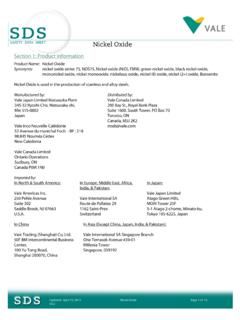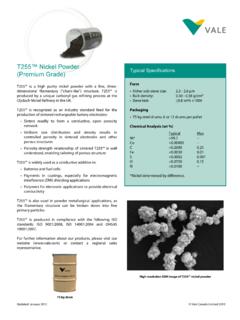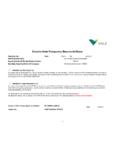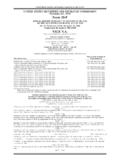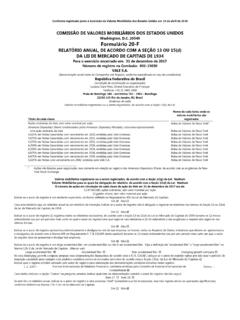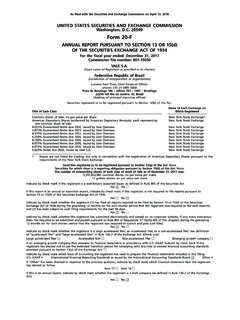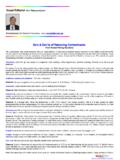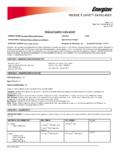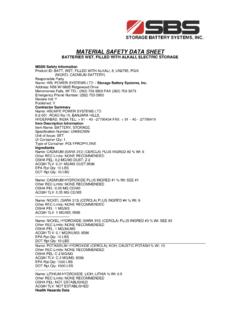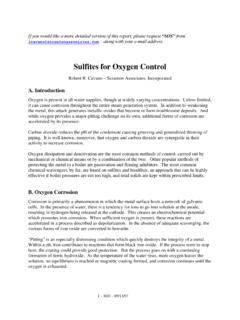Transcription of Nickel Oxide - Vale
1 Updated: 02-Dec-2015 Nickel Oxide Page 1 of 13 Updated: 01/08 Nickel Powder Type 123 Page 2 of 3 (ACCORDING TO EC-REGULATION 1907/2006 (REACH) & 1272/2008 (CLP)) Section 1. Identification of the Substance and Company Product Identification: Product Name: Nickel Oxide Synonyms: Nickel Oxide sinter 75 NOS75 Nickel Oxide (NiO) FMW Green Nickel Oxide Black Nickel Oxide Mononickel Oxide Nickel monoxide Nickelous Oxide Nickel (II) Oxide Nickel (2+) Oxide Bunsenite TNOS Japanese Nickel Oxide EC No: 215-215-7 / 234-323-5 CAS No: 1313-99-1 / 11099-02-8 REACH Registration number: see Section 3 Uses Identified Uses: - Industrial use of powdered and shaped Nickel Oxide containing catalysts (A) - Industrial use of Nickel Oxide -containing catalysts for the production of catalysts containing other Nickel compounds (B) - Production of Nickel based powders from Nickel Oxide - Production of Nickel -containing electronics and thermally functioning ceramics - Production of Nickel -containing enamel frits - Production of Nickel -containing pigments - Production of Nickel -containing glass - Stainless, special steels and special alloys manufacturing Uses Advised Against: - None Identified.
2 Exposure Scenarios: See Annex 1 Company Identification Vale Europe Limited Clydach, Swansea SA6 5QR Telephone Number: +44 (0) 1792 842501 For Fire, Spill, or chemical emergency call CHEMTREC: +(44)-870-8200418 Nickel Oxide Updated: 02-Dec-2015 Nickel Oxide Page 2 of 13 Section 2. Hazards Identification Classification of the Substance: Classification according Regulation (EC) No. 1272/2008 Skin Sensitization Category 1 Carcinogenicity Category 1A Specific Target Organ Toxicity, Repeated exposure Category 1 Aquatic Chronic Category 4 Hazard Pictograms: GHS07 - Exclamation mark, GHS08 - Health Hazard Signal Word: Danger Hazard Statements: H317 - May cause an allergic skin reaction. H350 - May cause cancer by inhalation H372 - Causes damage to lungs through prolonged or repeated inhalation exposure H413 - May cause long lasting harmful effects to aquatic life.
3 Precautionary Statements: P201, P202, P260, P261, P264, P270, P272, P273, P280, P302+P352, P308+P313, P333+P313, P314, P321, P362+P364, P405, P501 : Label elements Labelling according to Regulation (EC) No 1272/2008 Product identifier: Nickel Oxide CAS #: 1313-99-1 / 11099-02-8 Symbols: GHS07 - Exclamation mark, GHS08 - Health Hazard Signal Word: Danger Hazard Statements: H317, H350, H372, H413 Precautionary Statements: P202, P261, P273, P302+P352, P501 For full text of Precautionary statements see section 15. Section 3. Composition Substance Mixture Typical Analysis: Updated: 02-Dec-2015 Nickel Oxide Page 3 of 13 Hazardous Ingredients Typical Composition (%) Number EINECS/EC Label No. Nickel Oxide (NiO) 98 1313-99-1 215-215-7 Cobaltous Oxide (CoO) 0 - 1307-96-6 215-154-6 Nickel hydroxide 0 12054-48-7 235-008-05 REACH Registration # s: 01-2119467172-41-XXXX Vale Europe Limited 01-2119467172-41-XXXX Vale Japan Limited (Vale Europe Limited acting as Only Representative) Section 4.
4 First Aid Measures Ingestion: No specific first aid required. Inhalation: No specific first aid required. Skin: Remove contaminated clothing, and wash affected areas thoroughly with soap and water. If skin irritation or rash occurs: Get medical advice/attention. Show label if possible. Eyes: Irrigate eyeball thoroughly with water for at least 10 minutes. If discomfort persists seek medical attention. Most important symptoms and affects, both acute and delayed Skin contact: Rash Eye contact: Redness Indication of immediate medical attention and special treatment needed No special requirements Section 5. Fire Fighting Measures Suitable extinguishing media: Any, type to be selected according to materials stored in the immediate neighbourhood.
5 Special risks: Non-flammable. Extinguish surrounding fires with appropriate methods. Special protective equipment for fire fighting: None needed. Wear protective equipment if required for other materials within the immediate vicinity. Section 6. Accidental Release Measures Person related precautionary measures: Avoid generation of dusty atmospheres. Do not inhale dusts. Contaminated work clothing should not be allowed out of the workplace. Use personal protective equipment as required. Wash hands, and face thoroughly after handling. Updated: 02-Dec-2015 Nickel Oxide Page 4 of 13 Environmental Protection measures: Spillages and uncontrolled discharges must be prevented from entering waterways. Procedures for cleaning/absorption: Pick up and replace in original container.
6 Nickel -containing material is normally collected to recover Nickel values. Section 7. Handling And Storage Precautions for Safe Handling: Prevent the generation of inhalable dusts by the use of suitable ventilation. Do not inhale dust. Wear appropriate nationally approved respirators if handling is likely to cause the concentration limits of airborne Nickel to exceed the locally prescribed exposure limits. Wear suitable protective clothing and gloves. Contaminated work clothing should not be allowed out of the workplace Conditions for Safe Storage: Keep in the container supplied, and keep container closed when not in use. Local regulations should be followed regarding the storage of this product.
7 Section 8. Exposure Controls / Personal Protection Exposure Limits: Nickel Oxide (NiO) CAS 1313-99-1 Exposure Limit (mg/m3) Year ACGIH TLV-TWA 1 * as Ni 2008 UK WEL 2 as Ni 2011 Japan 1 as Ni 2012 Korea as Ni 2006 China 1 as Ni 2007 * Inhalable fraction Insoluble inorganic fraction Environmental Limits: PNEC s Compartment Unit PNEC Freshwater g Ni/L (bioavailable) Marine g Ni/L Terrestrial mg Ni/kg Updated: 02-Dec-2015 Nickel Oxide Page 5 of 13 DNEL s Unit DNEL Dermal Long-term local mgNi/cm2/day Inhalation Acute local mgNi/m3 Long-term systemic mgNi/m3 Long-term local mgNi/m3 Occupational exposure controls: Do not inhale dust. Mechanical extraction ventilation may be required if user operations change it to other physical or chemical forms, whether as end products, intermediates or fugitive emissions, which are inhalable.
8 Maintain airborne Nickel levels as low as possible. Avoid repeated skin contact. PPE Respiratory protection: If required, use an approved respirator with particulate filters. Eye protection: None Hand & Skin Protection: Wear suitable protective clothing and gloves, which should be selected specifically for the working place, depending on concentration and quantity of the hazardous material (overalls and leather/rubber gloves). Wash skin thoroughly after handling and before eating, drinking or smoking. Change contaminated clothing frequently. Launder clothing and gloves as needed. Use of skin-protective barrier cream advised. Section 9. Physical And Chemical Properties Solid, granular dark grey material.
9 Physical state at 20 C and kPa solid Melting / freezing point >1900 C Boiling point Not applicable Relative density g/cm3 at 20 C Vapour pressure Not applicable Surface tension Not applicable Water solubility g/l at 20 C (green Nickel Oxide ) g/l at 20 C (black Nickel Oxide ) Partition coefficient n-octanol/water (log value) Not applicable Flash point Not applicable Flammability Non-flammable Explosive properties Not applicable Updated: 02-Dec-2015 Nickel Oxide Page 6 of 13 Self-ignition temperature >400 C Oxidising properties Non-oxidising Granulometry < of particles with a diameter <100 um Stability in organic solvents and identity of relevant degradation products Not applicable Dissociation constant Not applicable Viscosity Not applicable Section 10.
10 Stability And Reactivity Reactivity Stable under normal conditions. Chemical stability Stable under normal conditions. Possibility of hazardous reactions Stable under normal conditions. Conditions to avoid None. Incompatible materials None. Hazardous Decomposition Product(s) No information available Section 11. Toxicological Information As a mixture the toxicological properties of this product are unknown. The toxicology of the reported ingredients are summarized below. Nickel Oxide Acute Toxicity: a) Oral: Non toxic - LD50 ORAL RAT >11,000 mg/kg (green); 9,990 (black) b) Inhalation: Non toxic - LD50 INHAL RAT > mg/m3 (green); > mg/m3 (black) c) Dermal: No information available. Corrosivity/Irritation: a) Respiratory Tract: No classification b) Skin: Not corrosive/irritating.
